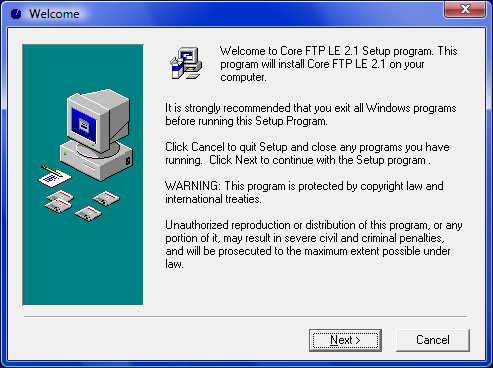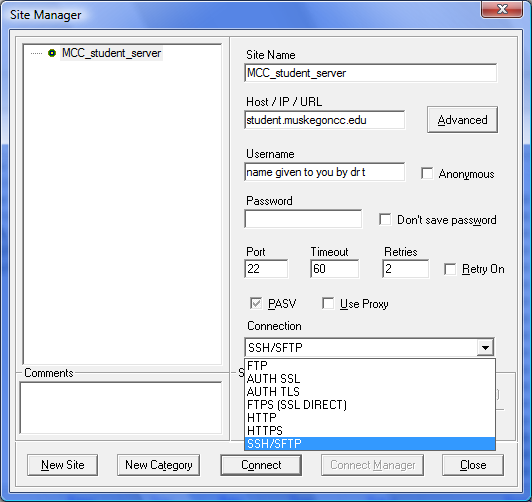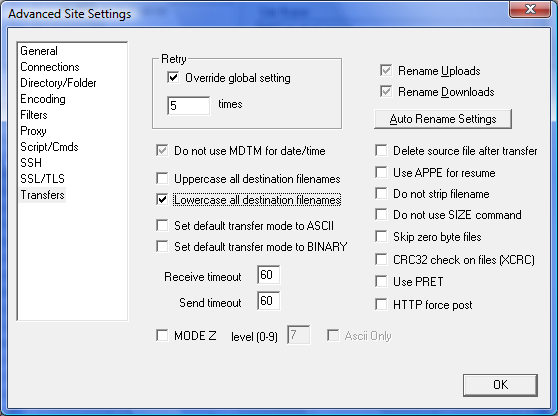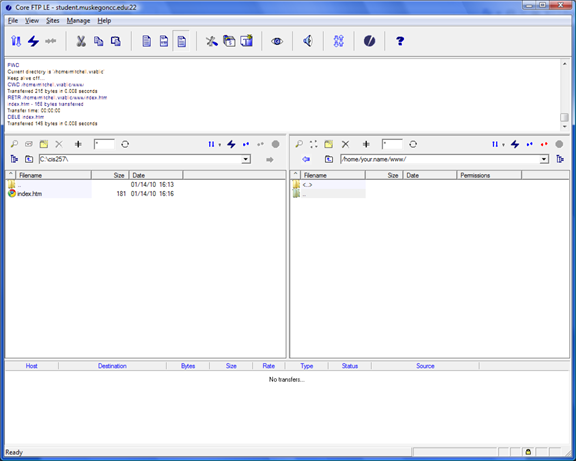
Class Topics
- Homework homepages
- File Transfer Protocol software
- Linking to student accounts
- Creating a subdirectory on the web server
- Copying files to web server
Online Topic (DueWeek 4)
Provide the URL for a poorly designed Web site and describe at least one feature you think looks bad, does not works well or in some way makes the site annoying to visit.
- No quiz this week.
- Publish your index.htm in the WWW folder on the college's student Web server using the account name emailed to you by Dr. T. (50 points). You will need to have installed secure FTP software on your home computer to complete this part of the assignment. Core FTP is available for free and instructions on how to obtain and install a copy of this software are found in the FYI section below.
- Use the World Wide Web Consortium's HTML/XHTML Validator on the Homework Homepage (index.htm) you just published on the college's Web server. Once your code validates as XHTML complaint, email the validation results page to Dr. T. at Tim.Trainor@ttdk.com (50 points). Other HTML verifiers can be used when prior consent is given by Dr. T.
FYI: FTPing Web Pages to Your Web Site
To publish a Web page you need to have an account on a Web server and Secure File Transfer Protocol (SFTP) software that allows you to copy the related HTML/XHTML files to the server. One popular freeware version is available from Core FTP at http://www.coreftp.com. This is not an endorsement of Core FTP and any SFTP client can be used to publish your Web page homework on the college's Web server.
Dr. T. has established accounts on the college's student Web server for every student. Each account has an unique username and password. The username actually corresponds to a file folder on the Web Server. For example, Diane Krasnewich has been assigned the username krasned and the URL for her Web site on the college's student server would be http://student.muskegoncc.edu/~krasned.
Installing Secure File Transfer Protocol Software
The following procedures are for installing Core FTP on PCs using the Windows operating syste:
- Use your browser to display the download page at coreftp.com.
- Click on the download link for the free version.
- Click on the Run button. You will need to do this twice.
- Once you see the Welcome dialog box (see below), click on the Next button and follow the instructions. Use the default options whenever possible.

SFTP Software Setup
Next you need to identify the Web address of the server that will host the Web pages you design as part of Core FTP's Site Manager as shown below.
- Run Core FTP by selecting the desktop shortcut or using the Start button's Programs option to select Core FTP, then click on Core FTP again.
- Click Yes when asked to make Core FTP your default Client FTP software.
- Click Yes when asked to edit all ascii files with Notepad.
- Type MCC student server in Site Name text box.
- Type student.muskegoncc.edu in Host / IP /URL text box.
- Type the username Dr. T. gave you in Username text box.
- DO NOT enter your password. Dr. T. recommends leaving this area blank and entering it manually when necessary as a security precaution. If you enter your password in the Password text box the software will remember it.
- The Port text box should be set to 22.
- Use the Connection drop down list box to select that SSH/SFTP option (see figuer below).
- Click on the Advanced button, select the Directory/Folder option and type www in the Remote Start Folder text box.
- Note: If you have already established a file folder for your CIS257 homework you can enter it in the Local Start Folder text box while you have the Advanced Site Settings dialog box open. As an alternative use the ... button to find the folder instead of typing in the path.

Set Filename Transfer to Lowercase
The college's student server uses Linux as an operating system. Since Linux is case sensitive, Dr. T. recommends that you write all filenames using lower case characters to avoid confusion. The following steps assures that all filenames are in lower case when you FTP them to the Web server.
- If necessary, in the Site Manager window click on the Advanced button to open the Advanced Site Settings dialog box shown below.
- Select Transfers in the text box found on the left.
- Click on the Lowercase all destination filenames check box to make this option active.
- Click on the OK button to close the Advanced Site Settings dialog box.

Running SFTP Software
All of the preceding steps are performed once. Now comes the procedures you will repeat every time you want to FTP (transfer) files from your personal computer to the Web server. At this point you should have the Site Manager window open.
- Click on the Connect button.
- Enter your password (ask Dr. T. if you have forgotten) into the Enter Password dialog box and press the Enter key or click on OK.
- Click on Yes when ask to Store key in SSH cache. You will only be asked to do this once.
- When you connect to the Web server both the left and right panes of the FTP window will display folder and file names as shown below. The left pane displays folders and files maintained by your computer--Drive C:\cis257 in this example. The right pane displays folders and files maintained by the Web server--/home/student/www in the right pane below.

Transfer Files from Your Disk Drive to Student Server
Your index.htm and other HTML/XHTML files must go into the server's www file folder to be accessible to others over the Internet. Core FTP works like Windows Explorer or My Computer in that you navigate within the disk drives by double-clicking on folders to open them, use the Up Directory button to go back to the parent file folder and use the Directory Tree button to go from disk drive to disk drive.
- In left pane open the drive and file folder with the Web page you want to post. In this case it is index.htm or index.html
- Highlight file your want to FTP. Hold down the Ctrl key when selecting more than one filename.
- Make sure the folder you want to use on the server is open. In this case your www folder should be open as shown above. The www folder is automatically opened if you include it in the Site Manager's Remote Start Folder text box.
- Drag the highlighted file(s) from the left pane over to the right pane.
FTP Software Does Not Connect
Stuff happens and it is not unusual to have the FTP software fail to connect the first time you try. Most likely you have made a typo when entering the FTP Host address, the username or password. Double-check them and try again. Remember Linux servers are case sensitive. Here are some procedures to help you when you need to try again.
- Click on the Site Manager button or open the Sites menu and click on the Site Manager option to return to the Site Manager window. This is where you double-check the host address and username.
- Click on the Connect button and make sure type the password exactly like it was given to you--remember the server is case sensitive.
Make a New Folder (Directory)
The college's Web server is setup to look for your Web pages in a www file folder and this folder should be in place when you open you account using an FTP client. These are the steps you need to use if the www folder is not there or if you need to create a subordinate folder within the www folder:
- Click within the right pane to activate it.
- Click on the Make New Directory button.
- Enter new folder name into the Enter dialog box and press Enter or click on OK.
- The new folder should appear in the right pane
Breaking the Connection
When you are done you can use the Site Manager to disconnect from one server and connect to another Web server. If you are done for the day, then you just close the FTP software window and click on the OK button to confirm you want to shut down Core FTP. Click on the Don't Ask Again check box to skip this step.




